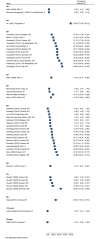Prevalence and impact of combined vision and hearing (dual sensory) impairment: A scoping review
- PMID: 37192147
- PMCID: PMC10187940
- DOI: 10.1371/journal.pgph.0001905
Prevalence and impact of combined vision and hearing (dual sensory) impairment: A scoping review
Abstract
Hearing and vision impairments are common globally. They are often considered separately in research, and in planning and delivering services. However, they can occur concurrently, termed dual sensory impairment (DSI). The prevalence and impact of hearing and vision impairment have been well-examined, but there has been much less consideration of DSI. The aim of this scoping review was to determine the nature and extent of the evidence on prevalence and impact of DSI. Three databases were searched: MEDLINE, Embase and Global Health (April 2022). We included primary studies and systematic reviews reporting the prevalence or impact of DSI. No limits were placed on age, publication dates, or country. Only studies where the full text was available in English were included. Two reviewers independently screened titles, abstract, full texts. Data were charted by two reviewers independently using a pre-piloted form. The review identified 183 reports of 153 unique primary studies and 14 review articles. Most evidence came from high-income countries (86% of reports). Prevalence varied across reports, as did age groups of participants and definitions used. The prevalence of DSI increased with age. Impact was examined across three broad groups of outcomes-psychosocial, participation, and physical health. There was a strong trend towards poorer outcomes for people with DSI across all categories compared to people with one or neither impairment, including activities of daily living (worse for people with DSI in 78% of reports) and depression (68%). This scoping review highlights that DSI is a relatively common condition with substantial impact, particularly among older adults. There is a gap in evidence from low and middle-income countries. There is a pressing need for a consensus position on the definition(s) of DSI and standardisation of reporting age groups to enable reliable estimates to be ascertained and compared and responsive services developed.
Copyright: © 2023 Bright et al. This is an open access article distributed under the terms of the Creative Commons Attribution License, which permits unrestricted use, distribution, and reproduction in any medium, provided the original author and source are credited.
Conflict of interest statement
The authors have declared that no competing interests exist.
Figures




Comment in
-
Hearing intervention and cognitive decline: the ACHIEVE trial.Lancet. 2024 Jul 6;404(10447):29. doi: 10.1016/S0140-6736(24)00711-6. Lancet. 2024. PMID: 38971589 No abstract available.
-
Hearing intervention and cognitive decline: the ACHIEVE trial.Lancet. 2024 Jul 6;404(10447):29-30. doi: 10.1016/S0140-6736(24)00712-8. Lancet. 2024. PMID: 38971590 No abstract available.
References
-
- Bourne RR, Flaxman SR, Braithwaite T, Cicinelli MV, Das A, Jonas JB, et al.. Magnitude, temporal trends, and projections of the global prevalence of blindness and distance and near vision impairment: a systematic review and meta-analysis. The Lancet Global Health. 2017;5(9):e888–e97. doi: 10.1016/S2214-109X(17)30293-0 - DOI - PubMed
-
- Wittich W, Southall K, Sikora L, Watanabe DH, Gagné J-P. What’s in a name: Dual sensory impairment or deafblindness? British Journal of Visual Impairment. 2013;31(3):198–207.
-
- World Federation of The Deafblind. At risk of exclusion from CRPD and SDGs implementation: Inequality and Persons with Deafblindness 2018 [cited 2023 23/03]. https://www.wfdb.eu/wp-content/uploads/2019/06/WFDB_complete_Final.pdf.
Publication types
Grants and funding
LinkOut - more resources
Full Text Sources
Miscellaneous
